Cover Page
Other titles published in this series
Title: Model Predictive Control System Design and Implementation Using MATLAB®
ISBN 1848823304
Advances in Industrial Control
Series Editors’ Foreword
Preface
About this Book
Development of this Book
Theory
Practice
Presentation
Book Structure
Acknowledgements
Contents (with page links)
List of Symbols and Abbreviations
1 Discrete-time MPC for Beginners
2 Discrete-time MPC with Constraints
3 Discrete-time MPC Using Laguerre Functions
4 Discrete-time MPC with Prescribed Degree of Stability
5 Continuous-time Orthonormal Basis Functions
6 Continuous-time MPC
7 Continuous-time MPC with Constraints
8 Continuous-time MPC with Prescribed Degree of Stability
9 Classical MPC Systems in State-space Formulation
10 Implementation of Predictive Control Systems
References
Index
List of Symbols and Abbreviations
Symbols
Abbreviations
1 Discrete-time MPC for Beginners
1.1 Introduction
1.1.1 Day-to-day Application Example of Predictive Control
1.1.2 Models Used in the Design
1.2 State-space Models with Embedded Integrator
1.2.1 Single-input and Single-output System
1.2.2 MATLAB Tutorial: Augmented Design Model
1.3 Predictive Control within One Optimization Window
1.3.1 Prediction of State and Output Variables
1.3.2 Optimization
1.3.3 MATLAB Tutorial: Computation of MPC Gains
1.4 Receding Horizon Control
1.4.1 Closed-loop Control System
1.4.2 MATLAB Tutorial: Implementation of Receding Horizon Control
1.5 Predictive Control of MIMO Systems
1.5.1 General Formulation of the Model
1.5.2 Solution of Predictive Control for MIMO Systems
1.6 State Estimation
1.6.1 Basic Ideas About an Observer
1.6.2 Basic Results About Observability De.nition of Observability
1.6.3 Kalman Filter
1.6.4 Tuning Observer Dynamics
1.7 State Estimate Predictive Control
1.8 Summary
Problems
2 Discrete-time MPC with Constraints
2.1 Introduction
2.2 Motivational Examples
2.3 Formulation of Constrained Control Problems
2.3.1 Frequently Used Operational Constraints
2.3.2 Constraints as Part of the Optimal Solution
2.4 Numerical Solutions Using Quadratic Programming
2.4.1 Quadratic Programming for Equality Constraints
2.4.2 Minimization with Inequality Constraints
2.4.3 Primal-Dual Method
2.4.4 Hildreth’s Quadratic Programming Procedure
2.4.5 MATLAB Tutorial: Hildreth’s Quadratic Programming
2.4.6 Closed-form Solution of λ*
2.5 Predictive Control with Constraints on Input Variables
2.5.1 Constraints on Rate of Change
2.5.2 Constraints on Amplitude of the Control
2.5.3 Constraints on Amplitude and Rate of Change
2.5.4 Constraints on the Output Variable
2.6 Summary
Problems
3 Discrete-time MPC Using Laguerre Functions
3.1 Introduction
3.2 Laguerre Functions and DMPC
3.2.1 Discrete-time Laguerre Networks
3.2.2 Use of Laguerre Networks in System Description
3.2.3 MATLAB Tutorial: Use of Laguerre Functions in System Modelling
3.3 Use of Laguerre Functions in DMPC Design
3.3.1 Design Framework
3.3.2 Cost Functions
3.3.3 Minimization of the Objective Function
3.3.4 Convolution Sum
3.3.5 Receding Horizon Control
3.3.6 The Optimal Trajectory of Incremental Control
3.4 Extension to MIMO Systems
3.5 MATLAB Tutorial Notes
3.5.1 DMPC Computation
3.5.2 Predictive Control System Simulation
3.6 Constrained Control Using Laguerre Functions
3.6.1 Constraints on the Di.erence of the Control Variable
3.6.2 Constraints on the Amplitudes of the Control Signal
3.7 Stability Analysis
3.7.1 Stability with Terminal-State Constraints
3.7.2 Stability with Large Prediction Horizon
3.8 Closed-form Solution of Constrained Control for SISO Systems
3.8.1 MATLAB Tutorial: Constrained Control of DC Motor
3.9 Summary
Problems
4 Discrete-time MPC with Prescribed Degree of Stability
4.1 Introduction
4.2 Finite Prediction Horizon: Re-visited
4.2.1 Motivational Example
4.2.2 Origin of the Numerical Conditioning Problem
4.3 Use of Exponential Data Weighting
4.3.1 The Cost Function
4.3.2 Optimization of Exponentially Weighted Cost Function
4.3.3 Interpretation of Results from Exponential Weighting
4.4 Asymptotic Closed-loop Stability with Exponential Weighting
4.4.1 Modification of Q and R Matrices
4.4.2 Interpretation of the Results
4.5 Discrete-time MPC with Prescribed Degree of Stability
4.6 Tuning Parameters for Closed-loop Performance
4.6.1 The Relationship Between P∞ and Jmin
4.6.2 Tuning Procedure Once More
4.7 Exponentially Weighted Constrained Control
4.8 Additional Benefit
4.9 Summary
Problems
5 Continuous-time Orthonormal Basis Functions
5.1 Introduction
5.2 Orthonormal Expansion
5.3 Laguerre Functions
5.4 Approximating Impulse Responses
5.5 Kautz Functions
5.5.1 Kautz Functions in the Time Domain
5.5.2 Modelling the System Impulse Response
5.6 Summary
Problems
6 Continuous-time MPC
6.1 Introduction
6.2 Model Structures for CMPC Design
6.2.1 Model Structure
6.2.2 Controllability and Observability of the Model
6.3 Model Predictive Control Using Finite Prediction Horizon
6.3.1 Modelling the Control Trajectory
6.3.2 Predicted Plant Response
6.3.3 Analytical Solution of the Predicted Response
6.3.4 The Recursive Solution
6.4 Optimal Control Strategy
6.5 Receding Horizon Control
6.6 Implementation of the Control Law in Digital Environment
6.6.1 Estimation of the States
6.6.2 MATLAB Tutorial: Closed-loop Simulation
6.7 Model Predictive Control Using Kautz Functions
6.8 Summary
Problems
7 Continuous-time MPC with Constraints
7.1 Introduction
7.2 Formulation of the Constraints
7.2.1 Frequently Used Constraints
7.2.2 Constraints as Part of the Optimal Solution
7.3 Numerical Solutions for the Constrained Control Problem
7.4 Real-time Implementation of Continuous-time MPC
7.5 Summary
Problems
8 Continuous-time MPC with Prescribed Degree of Stability
8.1 Introduction
8.2 Motivating Example
8.3 CMPC Design Using Exponential Data Weighting
8.4 CMPC with Asymptotic Stability
8.5 Continuous-time MPC with Prescribed Degree of Stability
8.5.1 The Original Anderson and Moore’s Results
8.5.2 CMPC with a Prescribed Degree of Stability
8.5.3 Tuning Parameters and Design Procedure Selection of the Exponential Weighting Factor
8.6 Constrained Control with Exponential Data Weighting
8.7 Summary
Problems
9 Classical MPC Systems in State-space Formulation
9.1 Introduction
9.2 Generalized Predictive Control in State-space Formulation
9.2.1 Special Class of Discrete-time State-space Structures
9.2.2 General NMSS Structure for GPC Design
9.2.3 Generalized Predictive Control in State-space Formulation
9.3 Alternative Formulation to GPC
9.3.1 Alternative Formulation for SISO Systems
9.3.2 Closed-loop Poles of the Predictive Control System
9.3.3 Transfer Function Interpretation
9.4 Extension to MIMO Systems
9.4.1 MNSS Model for MIMO Systems
9.4.2 Case Study of NMSS Predictive Control System
9.5 Continuous-time NMSS model
9.6 Case Studies for Continuous-time MPC
9.7 Predictive Control Using Impulse Response Models
9.8 Summary
Problems
10 Implementation of Predictive Control Systems
10.1 Introduction
10.2 Predictive Control of DC Motor Using a Micro-controller
10.2.1 Hardware Configuration�������������������������������������������������������������������������������������������������������
10.2.2 Model Development
10.2.3 DMPC Tuning
10.2.4 DMPC Implementation
10.2.5 Experimental Results Bene.ts of Imposing Constraints
10.3 Implementation of Predictive Control Using xPC Target
10.3.1 Overview
10.3.2 Creating a SIMULINK Embedded Function
10.3.3 Constrained Control of DC Motor Using xPC Target
10.4 Control of Magnetic Bearing Systems
10.4.1 System Identification����������������������������������������������������������������������������������������������������
10.4.2 Experimental Results
10.5 Continuous-time Predictive Control of Food Extruder
10.5.1 Experimental Setup
10.5.2 Mathematical Models
10.5.3 Operation of the Model Predictive Controller
10.5.4 Controller Tuning Parameters
10.6 Summary
References
Index (with page links)
Other titles published in this series (continued)
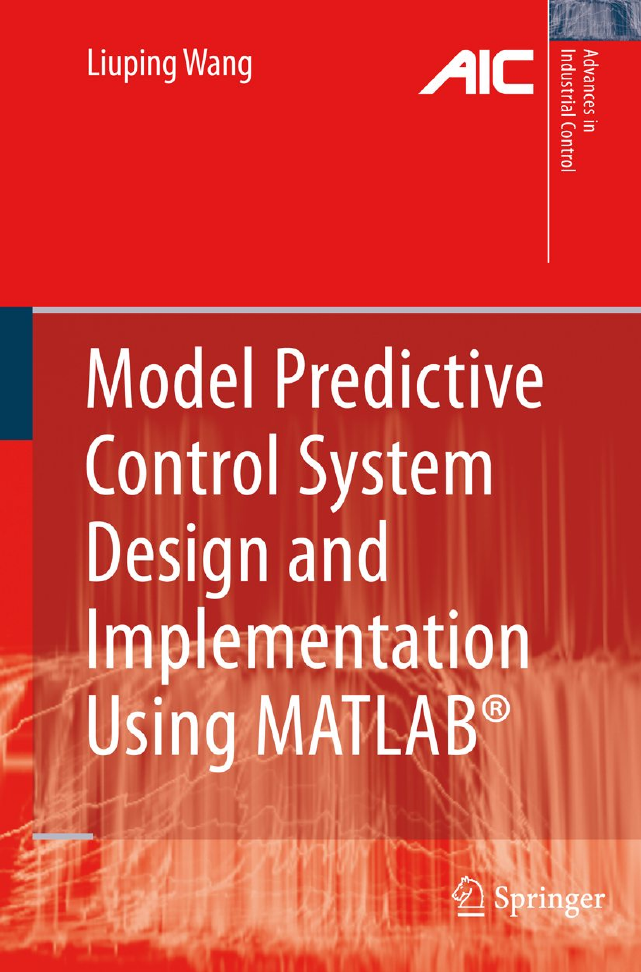
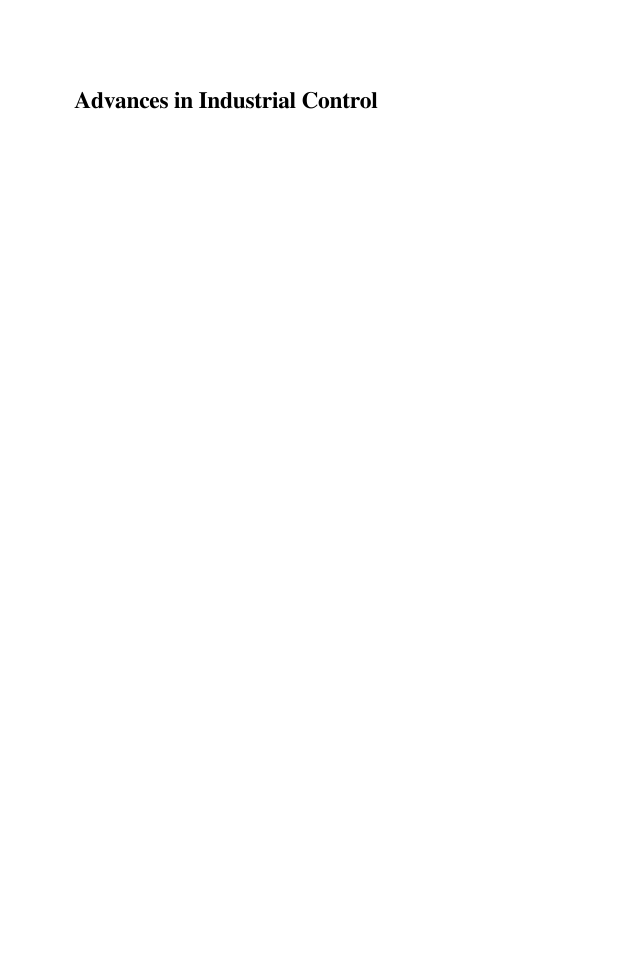
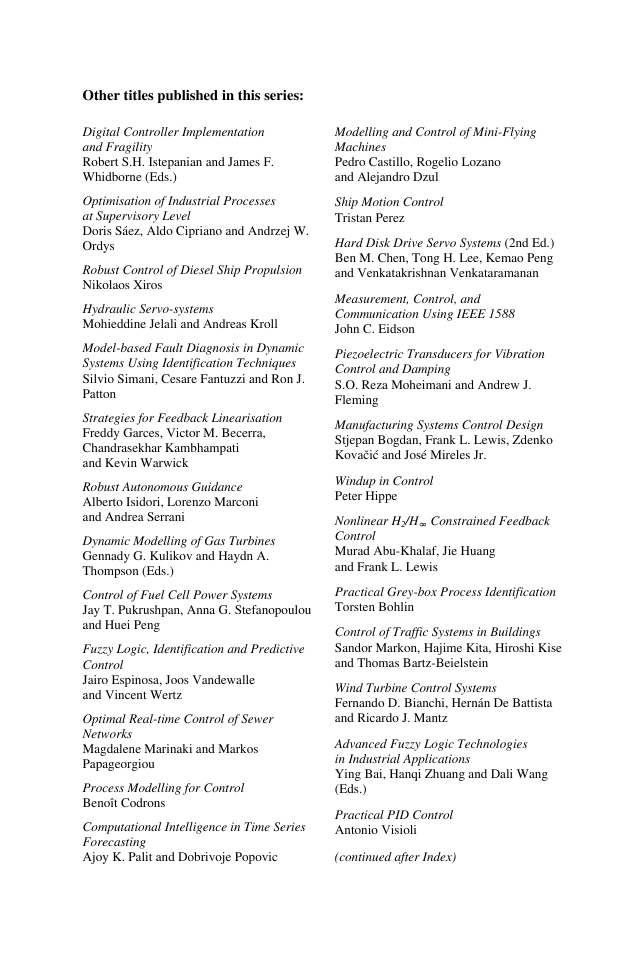
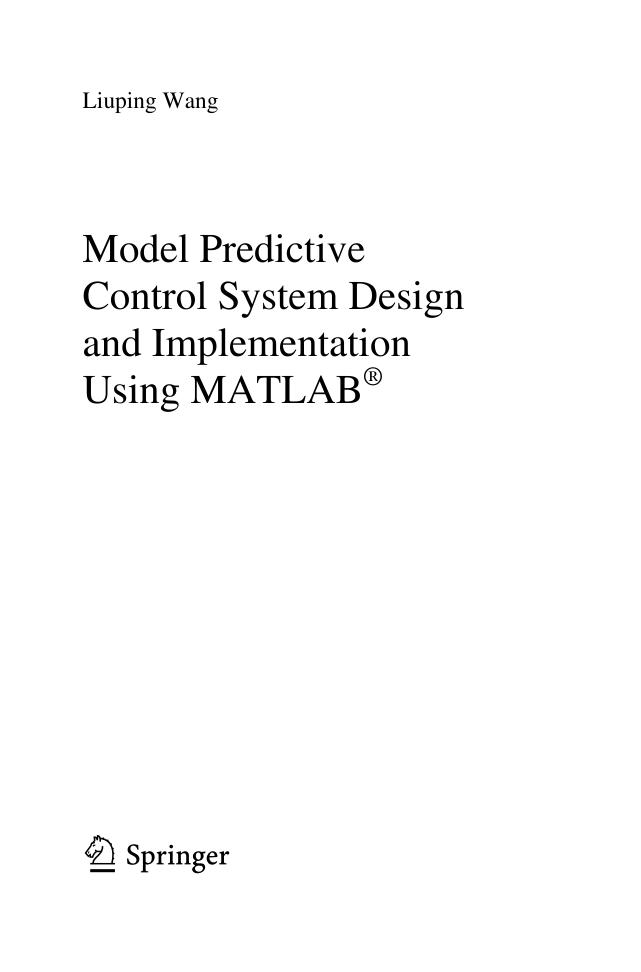

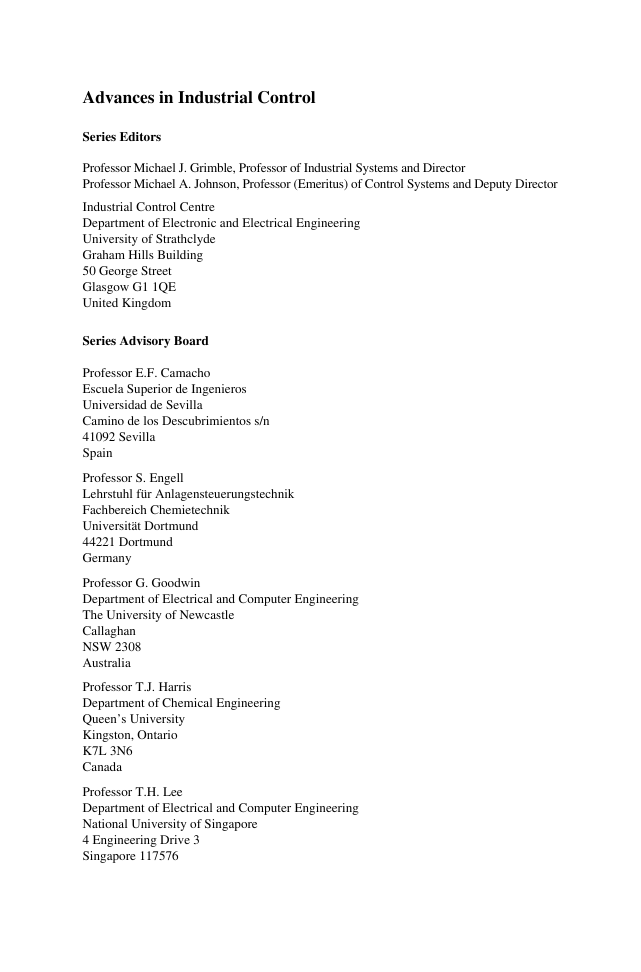
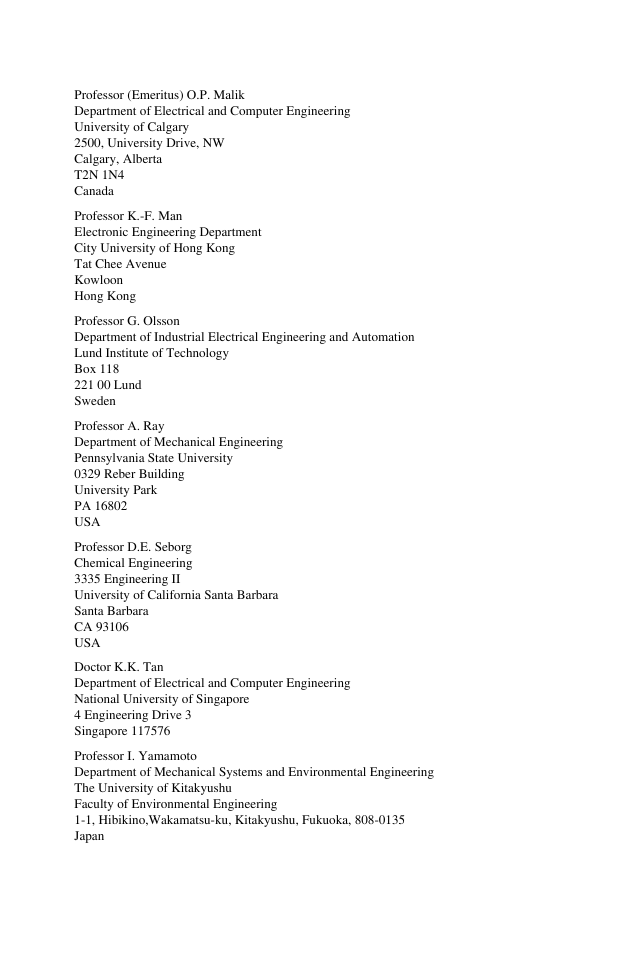









 2023年江西萍乡中考道德与法治真题及答案.doc
2023年江西萍乡中考道德与法治真题及答案.doc 2012年重庆南川中考生物真题及答案.doc
2012年重庆南川中考生物真题及答案.doc 2013年江西师范大学地理学综合及文艺理论基础考研真题.doc
2013年江西师范大学地理学综合及文艺理论基础考研真题.doc 2020年四川甘孜小升初语文真题及答案I卷.doc
2020年四川甘孜小升初语文真题及答案I卷.doc 2020年注册岩土工程师专业基础考试真题及答案.doc
2020年注册岩土工程师专业基础考试真题及答案.doc 2023-2024学年福建省厦门市九年级上学期数学月考试题及答案.doc
2023-2024学年福建省厦门市九年级上学期数学月考试题及答案.doc 2021-2022学年辽宁省沈阳市大东区九年级上学期语文期末试题及答案.doc
2021-2022学年辽宁省沈阳市大东区九年级上学期语文期末试题及答案.doc 2022-2023学年北京东城区初三第一学期物理期末试卷及答案.doc
2022-2023学年北京东城区初三第一学期物理期末试卷及答案.doc 2018上半年江西教师资格初中地理学科知识与教学能力真题及答案.doc
2018上半年江西教师资格初中地理学科知识与教学能力真题及答案.doc 2012年河北国家公务员申论考试真题及答案-省级.doc
2012年河北国家公务员申论考试真题及答案-省级.doc 2020-2021学年江苏省扬州市江都区邵樊片九年级上学期数学第一次质量检测试题及答案.doc
2020-2021学年江苏省扬州市江都区邵樊片九年级上学期数学第一次质量检测试题及答案.doc 2022下半年黑龙江教师资格证中学综合素质真题及答案.doc
2022下半年黑龙江教师资格证中学综合素质真题及答案.doc